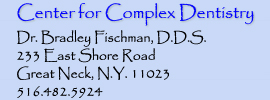 |
 |
Drs. Kahn, Tallents, Katzberrg, Ross, and Murphy, in their article, "Prevalence of dental occlusal variables and intra articular tempromandibular disorders: Molar relationship, lateral guidance, and nonworking side contacts" (J Prosthet Dent 1999;82:410-5) compaired the occlusal relationships of four groups of patients (1) asymptomatic with no MRI evidence of a displaced disc, (2) asymptomatic with MRI evidence of a displaced disc, (3) symptomatic with no MRI evidence of a displaced disc, and (4) symptomatic with MRI evidence of a displaced disc.
The results suggest the symptomatic patients have an increase in Class II Division I molar relationships. More interesting is the predominance of group function on both sides by the asymptomatic patients. On the right side, there was a greater incidence of cuspid rise in the symptomatic patients with displaced discs. All symptomatic patients had less nonworking side contacts than the asymptomatic patients.
This study viewed in conjuction with the electromyographic studies that demonstrate increased muscle activity during closing in group function vs. cuspid rise occlusion, supports the thought that there is no direct relation between a patient's occlusal pattern and TMD. There may be a relationship between asymptomatic patients and having a greater number of contacts in lateral excursions. It may therefore be contraindicated to arbitrarily change an asymptomatic patient's occlusal pattern to cuspid rise.
Drs. Corso, Siroto, Fiorellini, Rasool, Szmukler-Moncler, and Weber, in their article "Clinical and radiographic evaluation of early loaded free-standing dental implants with various coatings in beagle dogs" (J Prosthet Dent 1999;82:428-35) evaluated implants placed under masticatory load two days after placement. The implants all had a TPS (titanium plasma sprayed) coating, some were additionally coated with various HA coatings. All implants were ITI brand.
Individual crowns were placed on the implants and they were followed for six months. During that time the crowns did not have centric contacts, but were demonstrated to be in function during mastication. The diet became hard (Purina dog chow) after crown placement. Periotest, standerdized radiographs, as well as clinical examination were used to follow the 40 implants placed.
One implant failed and the rest remained firmly placed and succesful by all measures. There was a crestal bone loss of 1.6mm with the immediate loading, which seems constant in the literature. My thought is the lack of centric load reduces the occlusal stresses dramatically. This must be taken into consideration in any early load situation as well as some expected loss of crestal bone.
Dentures | Extreme Makeovers | Doctor's Credentials | Map & Policies | Contact Us
Home | Professional Referrals | Tidbits for Dentists | Newsletters for MDs